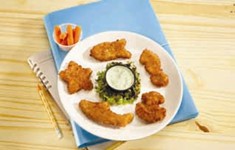
Schools have three years to implement the key changes in their lunch programs, but many have jumped on the bandwagon right away. For Ned Hawkins, corporate account manager for K-12 at High Liner Foods in Portsmouth, N.H., (with global headquarters in Lunenberg, Nova Scotia) it meant his usual task of selling products had been diverted to creating new items and new breading profiles, updating nutritionals and ensuring the company’s products meet USDA regulations.
“Making the products didn’t seem to be hard — we knew we needed to reduce sodium in batters and breadings, create items comprised of 51 percent whole grain breading and move toward chemical-free pollock,” he says. High Liner has changed the breading and flavor profiles of its fish sticks and tried to make its potato crunch item, a popular coating system for pollock portions, fillets and sticks, whole-grain compliant “without changing the shape of the products — so we’re not scaring kids further away from the lunch room,” Hawkins says.
“Because schools have to keep within caloric parameters and whole grain bread equivalents, we’ve had to architecturally design products to help them meet those parameters. For example, if they’re only allowed 10 grain servings per week, it’s easier for them to calculate that based on two grains per day. In the beginning we didn’t see it from the school’s perspective, but we realized if we didn’t revise our items to help the schools meet their challenges, they wouldn’t buy our products.”
The School Lunch Program represents 20 million pounds of mostly pollock to High Liner Foods, but the company also supplies cod and whiting to the program. Three years ago, when pollock became part of the USDA commodities program, its inclusion meant it became more affordable to many public schools.
“Public schools who offer free- and reduced-lunch programs are reimbursed a certain credit for every lunch,” says Pat Shanahan, program director of the Genuine Alaska Pollock Producers in Seattle. “That money can then be used to buy commodity items. Our inclusion in the commodity program was a big opening for us, as schools who weren’t previously thinking about pollock before are now more aware, and buying it more often.”
Between July 2011 and June 2012, more than 3 million pounds of pollock was sold through the USDA school lunch program, “which represents all new business for the pollock industry,” Shanahan says. In the first three months of the 2012-2013 school year 2.24 million pounds of pollock was sold. “There’s more demand now for fish, as schools look for healthier school lunches,” she says. “They know seafood is an important part of the diet, so we’re seeing high interest.”
The USDA is purchasing single-frozen Alaska pollock for its commodities program — product that is free of the preservative sodium tripolyphosphate and is lighter in color than twice-frozen pollock. “Simply put, the taste difference is apparent immediately and it looks different, too,” Hawkins says. “It doesn’t taste fishy. For approximately four pennies more per serving, you’re getting a product that kids actually eat, rather than one that lands in the trash bin after lunch.”
Some schools that do not participate in the commodities program are still purchasing twice-frozen pollock, but Hawkins says 40 percent of High Liner’s pollock sales are single-frozen.
The company is working on coating systems to flavor unbreaded pollock portions to schools, items used in dishes such as fish tacos and burritos. But breaded products still constitute the majority of sales, because kids are more accustomed to eating unbreaded chicken than they are unbreaded fish. “Still, we’ve been able to reduce the grains in some cases and use other ingredients so the final product doesn’t have as much of a breaded look to it,” he says. “And our sales have skyrocketed tremendously as we move toward a better product.”
“We’re trying to comply with the USDA rules and make it as easy as possible for schools to do that too, while still serving a hopefully enjoyable meal to kids — food that looks good and tastes delicious,” Hawkins says. “At food shows we take our fish patty and put it on a piece of whole-grain bread with lettuce, tomato and a local sauce. When you look at that, it doesn’t look like a machine-made, fast-food meal. And as we present it to school foodservice personnel, some of them are starting to bring those ideas back to schools around the country. Ironically, these new products are some of the best looking, best-tasting products we’ve ever made.”





